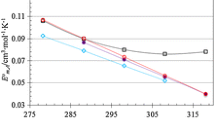Abstract
Three systems of the type amino acid or peptide-sodium chloride-water have been investigated over wide solute molality ranges using the isopiestic vapor pressure method. The amino acid employed was L-α-alanine, while the peptides were diglycine and triglycine. Equations were obtained for the activity coefficients of these compounds in the salt solutions in terms of the molalities of the solutes. The trace activity coefficients of the peptides were negative at low salt molality and became positive as the salt molality was increased. The limiting interaction parameters were calculated for the systems using the Kirkwood ion-dipole expression and empirical quantities derived from previous work to obtain the salt effect on the nonpolar and amide portion of the molecule. Good agreement was obtained between the calculated values and the experimental results in the case of diglycine, but they diverged in the case of triglycine. The calculated value for L-α-alanine is in poorer agreement with the experimental value than for the other amino acids studied previously.
Similar content being viewed by others
References
E. E. Schrier and R. A. Robinson,J. Biol. Chem. 246, 2870 (1971).
E. E. Schrier and R. A. Robinson,J. Biol. Chem. 245, 2432 (1970).
H. D. Ellerton, G. Reinfelds, D. E. Mulcahy, and P. J. Dunlop,J. Phys. Chem. 68, 398 (1964).
R. A. Robinson,J. Biol. Chem. 199, 71 (1952).
J. T. Edsall and J. Wyman,Biophysical Chemistry, Vol. 1 (Academic Press, New York, 1958), p. 318.
J. G. Kirkwood, inProteins, Amino Acids, and Peptides, E. J. Cohn and J. T. Edsall, eds. (Reinhold Publishing Corporation, New York, 1943), p. 277.
R. M. Roberts and J. G. Kirkwood,J. Am. Chem. Soc. 63, 1373 (1941).
J. T. Edsall and J. Wyman,Biophysical Chemistry, Vol. 1 (Academic Press, New York, 1958), p. 372.
F. L. Wilcox and E. E. Schrier,J. Phys. Chem. 75, 3757 (1971).
E. E. Schrier and E. B. Schrier,J. Phys. Chem. 71, 1851 (1967).
E. E. Schrier and S. Mann, unpublished work.
F. Franks, inWater, A Comprehensive Treatise, Vol. 2, F. Franks, ed. (Plenum Press. New York, 1973), p. 43.
Author information
Authors and Affiliations
Rights and permissions
About this article
Cite this article
Schrier, E.E., Robinson, R.A. Free energy relationships in aqueous amino acid and peptide solutions containing sodium chloride. J Solution Chem 3, 493–501 (1974). https://doi.org/10.1007/BF00648134
Received:
Revised:
Issue Date:
DOI: https://doi.org/10.1007/BF00648134




